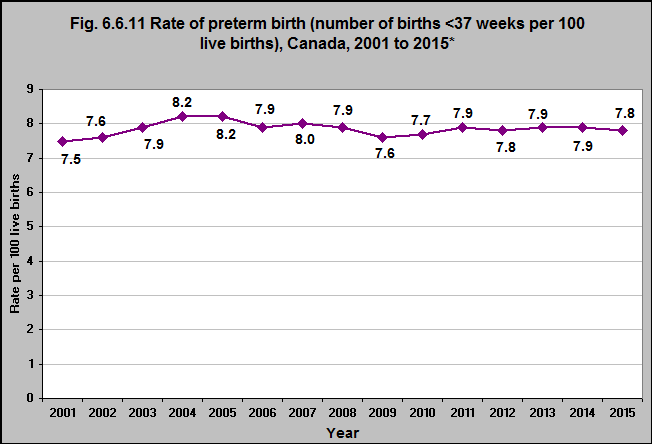Rates of preterm birth (number of births <37 weeks per 100 live births), Canada, 2001 to 2015

Note:
*Data from Ontario were excluded between 2001 and 2010 because of data quality concerns.
Source: CICH graphic created using data adapted from 2001 to 2010: Public Health Agency of Canada (PHAC). Perintatal Health indicators for Canada, 2013. A Report from the Canadian Perinatal Surveillance System. Statistics Canada Vital Statistics; and 2011 to 2015: Discharge Abstract Database (DAD) Hospital Morbidity Database (HMDB), Canadian Institute for Health Information; Fichier des hospitalisations MED-ECHO, Ministère de la Santé et des Services sociaux du Québec. https://apps.cihi.ca/mstrapp/asp/Main.aspx?Server=apmstrextprd_i&project=Quick%20Stats&uid=pce_pub_en&pwd=&evt=2048001&visualizationMode=0&documentID=029DB170438205AEBCC75B8673CCE822-accessed March 8th, 2017. (Please note the link defaults to an epidural rate table. Please hit the arrow button to access the preterm birth data for different years by province/territory)
The length of pregnancy – or gestation – has a large impact on the infant’s health – at birth and throughout life. Babies who are born too soon – preterm – and babies who are born at low birth weight are at increased risk of death, developmental problems and health challenges.1
Complications related to short gestation and low birth weight are the second leading cause of infant death in Canada – accounting for 20% of all infant deaths.2
In 2001, the preterm birth rate (number of births before 37 weeks per 100 live births) was 7.5 and in 2015 it was 7.8.
The rate varied from a low of 7.5 in 2001 to a high of 8.2 in 2004 and 2005.
Between 2000/02 and 2010/12, the low birth weight rate (less than 2,500 grams) increased in Canada from 5.6% to 6.1%.3
There is a growing body of research examining the association between exposure to environmental toxins and preterm birth and low birth weight. The evidence is strong for environmental tobacco smoke (ETS) and lead.4
Recently, studies have identified potential associations between exposure to common components of air pollution (particulate matter, sulfur dioxide, nitrogen dioxide and carbon monoxide) and preterm birth and low birth weight.4
Bisophenal A (BPA) exposure has been linked to a number of adverse outcomes such as preterm birth and low birth weight – but the data are not conclusive.5
Other research has shown an association between phthalate exposure during gestation and preterm birth and low birth weight.4
1UK HealthcareFact Sheet. Short And Long-Term Effects Of Preterm Birth Fact Sheet. 2016. https://ukhealthcare.uky.edu/health-and-wellness/publications/fact-sheets/mother-baby/Short-and-Long-Term-Effects-of-Preterm-Birth-Fact-Sheet/ – accessed April 28, 2017.
2Statistics Canada. Table 102-0562. Leading causes of death, infants, by sex, Canada. http://www5.statcan.gc.ca/cansim/a26?lang=eng&id=1020562 – accessed April 28, 2017.
Statistics Canada, Canadian Vital Statistics, Birth Database. The CANSIM table 102-4318 is an update of CANSIM table 102-4304. http://www5.statcan.gc.ca/cansim/a05?lang=eng&id=01024318 – accessed on July 24, 2017.
4Environmental Protection Agency. Children’s Health and the Environment Third Edition. 2013. https://www.epa.gov/sites/production/files/2015-06/documents/ace3_2013.pdf – accessed May 22, 2017.
5Rochester, J.R. (2013). Bisphenol A and human health: A review of the literature. Reproductive Toxicology, 42, 132-155.
